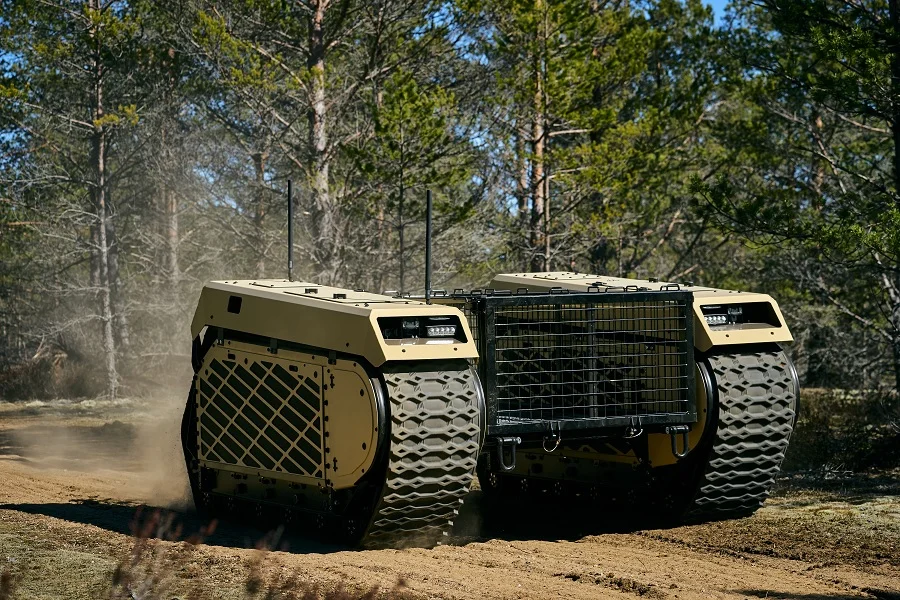Sweden has taken a significant step by integrating advanced robotic systems into its defense forces. Estonia’s Milrem Robotics, a global leader in the development of autonomous systems, has delivered its flagship THeMIS (Tracked Hybrid Modular Infantry System) Unmanned Ground Vehicle (UGV) to Sweden. This delivery, marking a pivotal moment in Swedish military innovation, will undergo trials and experimentation under the supervision of the Swedish Defence Materiel Administration (FMV), the Swedish Defence Research Agency, and the Swedish Armed Forces. The THeMIS UGV, equipped with Milrem Robotics’ Intelligent Functions Kit (MIFIK) for autonomous mobility, offers a revolutionary approach to enhancing military capabilities. Sweden’s decision to adopt this state-of-the-art unmanned platform is part of a broader strategy to harness robotics and artificial intelligence (AI) to bolster its defense capabilities and remain ahead in an increasingly complex security environment. The contract, signed during the prestigious Eurosatory 2024 defense and security exhibition, represents Sweden’s first official foray into integrating robotic technologies within its armed forces. The agreement was formalized by Brigadier General Jonas Lotsne, Director of Land Systems at FMV, and Sverker Svärdby, Managing Director of Milrem Robotics Sweden. The signing ceremony took place in the presence of Major General Jonny Lindfors, Chief of the Swedish Army, symbolizing Sweden’s commitment to embracing cutting-edge military technologies. This collaboration positions Sweden among the growing list of nations adopting unmanned systems to meet the evolving challenges of modern warfare.
Milrem Robotics’ THeMIS (Tracked Hybrid Modular Infantry System) is a versatile and robust platform, known for its adaptability across a wide range of missions. Originally acquired in its cargo variant, designed for resupply missions and logistical support, the THeMIS can be configured for diverse operational roles. Its open architecture allows integration with third-party systems, enabling rapid modification for tasks such as casualty evacuation, intelligence gathering, reconnaissance, and even combat operations. In its cargo variant, the THeMIS UGV is expected to play a crucial role in logistics, ensuring that Swedish ground forces have access to timely resupply, thus reducing the physical and cognitive burden on soldiers. The vehicle can autonomously navigate challenging terrains and deliver essential supplies to the frontlines, a capability that is becoming increasingly critical in the modern battlefield where rapid resupply is key to sustaining operations. What sets the THeMIS apart from other UGVs is its modularity and adaptability. While Sweden’s initial acquisition focuses on its cargo capabilities, the THeMIS platform is highly configurable, capable of serving in combat roles with integrated weapon systems. The THeMIS Combat UGV variant can be fitted with light or heavy machine guns, 40 mm grenade launchers, 30 mm autocannons, and anti-tank missile systems. The vehicle’s self-stabilizing remote-controlled weapon station provides precise fire support, increasing both the survivability and firepower of ground troops. It offers the advantage of engaging targets from a safe distance, minimizing exposure to hostile forces. In addition to combat operations, the THeMIS ISR (Intelligence, Surveillance, and Reconnaissance) variant offers advanced multi-sensor intelligence-gathering capabilities.

At the core of the THeMIS UGV’s advanced capabilities lies Milrem’s Intelligent Functions Kit (MIFIK), which enables autonomous mobility. MIFIK allows the vehicle to operate independently in complex environments, navigating obstacles and adapting to changing battlefield conditions. This autonomy not only reduces the operational load on human operators but also enhances the vehicle’s ability to perform under the most demanding conditions. Sweden’s adoption of the THeMIS is a testament to the increasing importance of autonomous systems in modern military strategy. Autonomous mobility reduces the need for direct human intervention, minimizing risk to personnel while allowing for faster and more efficient mission execution. The Swedish Defence Research Agency is expected to conduct extensive trials of MIFIK, ensuring that the system is fully optimized for Sweden’s unique operational needs. The versatility of the THeMIS platform makes it a key asset not just in conventional warfare but also in supporting special operations, border patrol, and homeland security missions. The Swedish Armed Forces are expected to explore the full range of capabilities offered by the THeMIS as they integrate the vehicle into their operational framework.
To ensure the seamless integration of the THeMIS UGV into its military operations, Sweden will undergo rigorous training programs for its personnel. Milrem Robotics has committed to providing comprehensive training, ongoing technical support, and system upgrades to ensure that Swedish forces can operate the platform effectively. This partnership between Milrem and Sweden underscores the critical role that robotics and AI will play in the future of warfare, not only in enhancing operational effectiveness but also in safeguarding human lives by reducing direct exposure to danger. Sweden’s decision to integrate the THeMIS UGV reflects a forward-thinking approach to modern warfare. As global security threats become more diverse and unpredictable, nations are increasingly turning to robotics and AI to maintain an edge. By adopting advanced unmanned systems, Sweden is positioning itself at the forefront of defense innovation, ensuring that its armed forces remain agile, adaptable, and prepared for the challenges of tomorrow. With its ability to perform a wide range of tasks, from logistics and reconnaissance to direct combat support, the THeMIS UGV is set to become a vital component of Sweden’s defense strategy. The success of the trials and experimentations will likely determine the future scope of Sweden’s investment in unmanned systems, potentially leading to further acquisitions and an expanded role for robotics in Swedish military operations.












